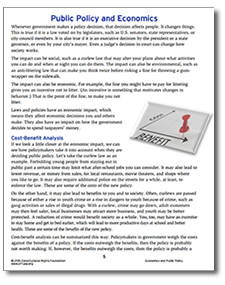Lessons 1 through 7
These core lessons provide students with key content and skills they need to choose an issue and begin taking civic actions:
Lesson 1: Citizenship Brainstorm
Students are introduced to Civic Action Project (CAP) and create a profile of citizenship that reflects the knowledge, skills, attitudes, and actions that they believe are important for effective citizenship in their communities.
Lesson 2: What’s Your Issue?
Students choose their CAP issue, form civic action groups, and complete the CAP Proposal Planner.
Lesson 3: Exploring Causes & Effects
Narrowing the focus of their CAP project will help students choose and complete effective civic actions. Students will meet in their CAP groups to identify specific causes or effects of their CAP issues and complete the Thinking It Through Planner (I).
Lesson 4: Public Policy and Your Issue
Students work in small groups to learn what public policy is and how it relates to their civic action projects before completing of Thinking It Through (II).
Lesson 5: Evaluating Public Policy
Students are introduced to policy analysis by examining policy goals, pros, and cons, and people involved in real-world case studies.
Lesson 6: Taking Civic Action
Students brainstorm civic actions before learning about the Montgomery Bus Boycott as a case study on building a constituency. At the end of the lesson, CAP group will record their next steps by completing a Civic Action Planner.
Lesson 7: Reflect & Report
Students complete the Reflect & Report Planner to share what they learned about the importance of civic engagement and to explore options for sharing what they’ve learned with a larger audience.
Supplemental Lessons
These supplemental lessons provide additional skill-building and U.S. government content as students continue their projects.
 Civic Action Survey provides students with an opportunity to discuss and examine the importance of surveys to measure public opinion about their CAP problem or issue. First, students will form pairs to take turns conducting and responding to a sample survey. Next students will learn about the types of questions that should be included in a survey. Finally students will convene in their civic action groups to brainstorm three different types of questions as the basis for their own civic action survey. Civic Action Survey provides students with an opportunity to discuss and examine the importance of surveys to measure public opinion about their CAP problem or issue. First, students will form pairs to take turns conducting and responding to a sample survey. Next students will learn about the types of questions that should be included in a survey. Finally students will convene in their civic action groups to brainstorm three different types of questions as the basis for their own civic action survey.
Persuading introduces students to the art of persuasion. First, they read about and discuss the three types of persuasion: logos, ethos, and pathos. Then students prepare two-minute persuasive talks on why the issue that they have chosen to address in CAP is important. Finally, in pairs, students present and critique one another’s talks.
Building Constituencies introduces students to the importance of gaining support to impact public policies. First, students complete a brief reading about the Montgomery Bus Boycott. Next, they examine documents created during the boycott and identify the civic actions taken to help build constituencies. Finally, in small groups, students brainstorm how they can get support for their CAP issue.
Persuading Policymakers informs students that legislative and executive bodies often hold public hearing and how students can make effective presentations at these hearings. First, students read about public hearings and techniques for making presentations at these hearings. Then students role play a city council and people appearing before it attempting to persuade policymakers on hypothetical issues.
___________________________________________________________________________________________
Introduce Students to the Link Between Economics and Public Policy
In this lesson, students first discuss making decisions in terms of trade-offs and opportunity costs. Then, students read and discuss a short article on doing cost-benefit analyses, using the minimum wage as a case study. In small groups, students conduct their own cost-benefit analysis of policy proposals that addresses local issues. More. . .
|

